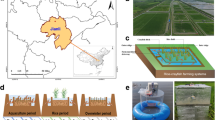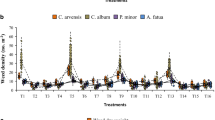Abstract
Water and nitrogen (N) are generally two of the most important factors in determining the crop productivity. Proper water and N managements are prerequisites for agriculture sustainable development in arid areas. Field experiments were conducted to study the responses of water productivity for crop yield (WP Y-ET ) and final biomass (WP B-ET ) of film-mulched hybrid maize seed production to different irrigation and N treatments in the Hexi Corridor, Northwest China during April to September in 2013 and also during April to September in 2014. Three irrigation levels (70%–65%, 60%–55%, and 50%–45% of the field capacity) combined with three N rates (500, 400, and 300 kg N/hm2) were tested in 2013. The N treatments were adjusted to 500, 300, and 100 kg N/hm2 in 2014. Results showed that the responses of WP Y-ET and WP B-ET to different irrigation amounts were different. WP Y-ET was significantly reduced by lowering irrigation amounts while WP B-ET stayed relatively insensitive to irrigation amounts. However, WP Y-ET and WP B-ET behaved consistently when subjected to different N treatments. There was a slight effect of reducing N input from 500 to 300 kg/hm2 on the WP Y-ET and WP B-ET , however, when reducing N input to 100 kg/hm2, the values of WP Y-ET and WP B-ET were significantly reduced. Water is the primary factor and N is the secondary factor in determining both yield (Y) and final biomass (B). Partial factor productivity from applied N (PFPN) was the maximum under the higher irrigation level and in lower N rate (100–300 kg N/hm2) in both years (2013 and 2014). Lowering the irrigation amount significantly reduced evapotranspiration (ET), but ET did not vary with different N rates (100–500 kg N/hm2). Both Y and B had robust linear relationships with ET, but the correlation between B and ET (R 2=0.8588) was much better than that between Y and ET (R 2=0.6062). When ET increased, WP Y-ET linearly increased and WP B-ET decreased. Taking the indices of Y, B, WP Y-ET , WP B-ET and PFP N into account, a higher irrigation level (70%–65% of the field capacity) and a lower N rate (100–300 kg N/hm2) are recommended to be a proper irrigation and N application strategy for plastic film-mulched hybrid maize seed production in arid Northwest China.
Similar content being viewed by others
References
Allen R G, Pereira L S, Raes D, et al. 1998. Crop evapotranspiration–guidelines for computing crop water requirements. FAO Irrigation and Drainage Paper 56. Rome: FAO.
Bradford K J, Hsiao T C. 1982. Physiological responses to moderate water stress. In: Lange O L, Nobel P S, Osmond C B, et al. Physiological Plant Ecology II: Water Relations and Carbon Assimilation. Berlin Heidelberg: Springer, 263–324.
Bryant K J, Benson V W, Kiniry J R, et al. 1992. Simulating corn yield response to irrigation timings: validation of the EPIC model. Journal of Production Agriculture, 5(2): 237–242.
Çakir R. 2004. Effect of water stress at different development stages on vegetative and reproductive growth of corn. Field Crops Research, 89(1): 1–16.
Chen X P, Cui Z L, Vitousek P M, et al. 2011. Integrated soil-crop system management for food security. Proceedings of the National Academy of Sciences of the United States of America, 108(16): 6399–6404.
Cui Z L, Zhang F S, Chen X P, et al. 2010. In-season nitrogen management strategy for winter wheat: Maximizing yields, minimizing environmental impact in an over-fertilization context. Field Crops Research, 116(1–2): 140–146.
de Wit C T. 1958. Transpiration and Crop Yields. Wageningen, The Netherlands: Wageningen University, 1–88.
Di Paolo E, Rinaldi M. 2008. Yield response of corn to irrigation and nitrogen fertilization in a Mediterranean environment. Field Crops Research, 105(3): 202–210.
Dobermann A. 2005. Nitrogen use efficiency-state of the art. In: IFA International Workshop on Enhanced Efficiency Fertilizers. Germany: Frankfurt, 28–30.
Du T S, Kang S Z, Sun J S, et al. 2010. An improved water use efficiency of cereals under temporal and spatial deficit irrigation in north China. Agricultural Water Management, 97(1): 66–74.
Du T S, Kang S Z, Zhang J H, et al. 2015. Deficit irrigation and sustainable water–resource strategies in agriculture for China’s food security. Journal of Experimental Botany, 66(8): 2253–2269.
English M, Raja S N. 1996. Perspectives on deficit irrigation. Agricultural Water Management, 32(1): 1–14.
Farré I, Faci J M. 2006. Comparative response of maize (Zea mays L.) and sorghum (Sorghum bicolor L.Moench) to deficit irrigation in a Mediterranean environment. Agricultural Water Management, 83(1–2): 135–143.
Fischer R A, Turner N C. 1978. Plant productivity in the arid and semiarid zones. Annual Review of Plant Physiology, 29(1): 277–317.
Fu Q P, Wang Q J, Shen X L, et al. 2014. Optimizing water and nitrogen inputs for winter wheat cropping system on the Loess Plateau, China. Journal of Arid Land, 6(2): 230–242.
Garcia A L, Marcelis L, García-Sánchez F, et al. 2007. Moderate water stress affects tomato leaf water relations in dependence on the nitrogen supply. Biologia Plantarum, 51(4): 707–712.
Geerts S, Raes D. 2009. Deficit irrigation as an on-farm strategy to maximize crop water productivity in dry areas. Agricultural Water Management, 96(9): 1275–1284.
Gheysari M, Mirlatifi S M, Bannayan M, et al. 2009. Interaction of water and nitrogen on maize grown for silage. Agricultural Water Management, 96(5): 809–821.
Hammad H M, Ahmad A, Abbas F, et al. 2012. Optimizing water and nitrogen use for maize production under semiarid conditions. Turkish Journal of Agriculture & Forestry, 36(5): 519–532.
Hanks R J. 1983. Yield and water-use relationships: an overview. In: Taylor H M, Jordan W R, Sinclair T R. Limitations to Efficient Water Use in Crop Production. Madison, WI: ASA, CSSA, SSSA, 393–411.
Islam M R, Garcia S C, Horadagoda A. 2012. Effects of irrigation and rates and timing of nitrogen fertilizer on dry matter yield, proportions of plant fractions of maize and nutritive value and in vitro gas production characteristics of whole crop maize silage. Animal Feed Science and Technology, 172(3–4): 125–135.
Jin L B, Cui H Y, Li B, et al. 2012. Effects of integrated agronomic management practices on yield and nitrogen efficiency of summer maize in North China. Field Crops Research, 134: 30–35.
Kang S Z, Shi W J, Zhang J H. 2000. An improved water-use efficiency for maize grown under regulated deficit irrigation. Field Crops Research, 67(3): 207–214.
Kang S Z, Hao X M, Du T S, et al. 2017. Improving agricultural water productivity to ensure food security in China under changing environment: From research to practice. Agricultural Water Management, 179: 5–17.
Lemaire G, Gastal F, Plénet D. 1997. Dynamics of N uptake and N distribution in plant canopies. Use of crop N status index in crop modelling. In: Lemaire G, Burns I G. Diagnostic Procedures for Crop N Management. Paris: INRA, 15–29.
Meng Q F, Sun Q P, Chen X P, et al. 2012. Alternative cropping systems for sustainable water and nitrogen use in the North China Plain. Agriculture, Ecosystems & Environment, 146(1): 93–102.
O’Leary M J, Rehm G W. 1990. Nitrogen and sulfur effects on the yield and quality of corn grown for grain and silage. Journal of Production Agriculture, 3(1): 135–140.
Ogola J B O, Wheeler T R, Harris P M. 2002. Effects of nitrogen and irrigation on water use of maize crops. Field Crops Research, 78(2–3): 105–117.
Pandey R K, Maranville J W, Admou A. 2000. Deficit irrigation and nitrogen effects on maize in a Sahelian environment: I. Grain yield and yield components. Agricultural Water Management, 46(1): 1–13.
Payero J O, Melvin S R, Irmak S, et al. 2006. Yield response of corn to deficit irrigation in a semiarid climate. Agricultural Water Management, 84(1–2): 101–112.
Ran H, Kang S Z, Li F S, et al. 2016. Effects of irrigation and nitrogen management on hybrid maize seed production in north-west China. Frontiers of Agricultural Science and Engineering, 3(1): 55–64.
Sadras V O, Richards R A. 2014. Improvement of crop yield in dry environments: benchmarks, levels of organization and the role of nitrogen. Journal of Experimental Botany, 65(8): 1981–1995.
Sampathkumar T, Pandian B J, Rangaswamy M V, et al. 2013. Influence of deficit irrigation on growth, yield and yield parameters of cotton–maize cropping sequence. Agricultural Water Management, 130: 90–102.
Sinclair T R, Bingham G E, Lemon E R, et al. 1975. Water use efficiency of field-grown maize during moisture stress. Plant Physiology, 56(2): 245–249.
Sinclair T R, Tanner C B, Bennett J M. 1984. Water-use efficiency in crop production. BioScience, 34(1): 36–40.
Steduto P, Albrizio R, Giorio P, et al. 2000. Gas-exchange response and stomatal and non-stomatal limitations to carbon assimilation of sunflower under salinity. Environmental and Experimental Botany, 44(3): 243–255.
Steduto P, Albrizio R. 2005. Resource use efficiency of field-grown sunflower, sorghum, wheat and chickpea: II. Water use efficiency and comparison with radiation use efficiency. Agricultural and Forest Meteorology, 130(3–4): 269–281.
Steduto P, Hsiao T C, Fereres E. 2007. On the conservative behavior of biomass water productivity. Irrigation Science, 25(3): 189–207.
Stone P J, Wilson D R, Reid J B, et al. 2000. Water deficit effects on sweet corn. I. Water use, radiation use efficiency, growth, and yield. Australian Journal of Agricultural Research, 52(1): 103–113.
Tanner C B, Sinclair T R. 1983. Efficient water use in crop production: research or re-search? In: Taylor H M, Jordan W A, Sinclair T R. Limitations to Efficient Water Use in Crop Production. Madison, WI: ASA, CSSA, SSSA, 1–27.
Uhart S A, Andrade F H. 1995. Nitrogen defeciency in maize: I. Effects on crop growth, development, dry matter partitioning, and kernel set. Crop Science, 35(5): 1376–1383.
Wei C Z, Ma T F, Wang X J, et al. 2012. The fate of fertilizer N applied to cotton in relation to irrigation methods and N dosage in arid area. Journal of Arid Land, 4(3): 320–329.
Zwart S J, Bastiaanssen W G M. 2004. Review of measured crop water productivity values for irrigated wheat, rice, cotton and maize. Agricultural Water Management, 69(2): 115–133.
Acknowledgments
This research was supported by the National Natural Science Foundation of China (51621061, 91425302, 51379208), the Research Projects of the Agricultural Public Welfare Industry in China (201503125), and the Discipline Innovative Engineering Plan (111 Program, B14002). We are very grateful to the anonymous reviewers and editors for their valuable comments on the manuscript.
Author information
Authors and Affiliations
Corresponding author
Rights and permissions
About this article
Cite this article
Ran, H., Kang, S., Li, F. et al. Responses of water productivity to irrigation and N supply for hybrid maize seed production in an arid region of Northwest China. J. Arid Land 9, 504–514 (2017). https://doi.org/10.1007/s40333-017-0017-3
Received:
Revised:
Accepted:
Published:
Issue Date:
DOI: https://doi.org/10.1007/s40333-017-0017-3




